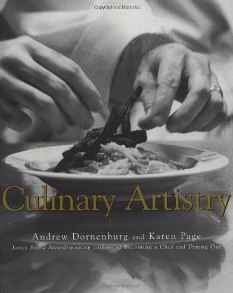Culinary Artistry
Dornenburg and Page use a distinctive style in their books about cooking and restaurant life, threading together numerous interviews about aspects of the art of cooking. At its best, this provides a consensus of successful cooks in their own words. At times, though, this book (like previous Dornenburg and Page ventures on chef training and restaurant reviewing) can read like Zagat’s, stringing together many short excerpts to construct an artificial consensus.
The core contribution of this book is a vast table of foods that go together, including both classic and modern combinations. Also of great interest are a list of parallel menus developed by prominent chefs of the 80’s and 90’s – comparing, say, the opening menu of Chez Panisse to what they’re doing today.
Why do some foods “go together”? Are these preferences purely memory and convention? Surely, contingency plays a big role in what we consider comfort food and in what we think delicious: Proust’s madeleines might have been donuts had he lived in San Francisco, though his time would still have been lost. Occasionally, you get a chemical incompatibility between two ingredients — asparagus is good and wine is good, you could imagine nice combinations, but the wine reacts with an enzyme in asparagus and so it’s not gonna work out. People form habits: some people always drink scotch, others drink vodka.
But I think there’s much more to be said on the subject. One suggestion here is that it’s nice to have ingredients that naturally get along: birds love grapes, for example, and poultry goes nicely with grape preparations and wine-rich sauces. Escoffier liked visual fantasies in this genre and things can easily get out of hand, but you can see why the affinity can make sense. Grant Achatz made an interesting observation about constructing tasting menus, finding that if people enjoy feasts more if they move from savory to sweet and then return to savory before dessert.
The title is perhaps unfortunate because Ruhlman’s Making of a Chef trilogy, the first volume of which appeared the following year, is deeply engaged in the question of whether cooking is an art, where Dornenburg and Page are chiefly using art as a consensus view of excellence. Their approach, depending as it does on the joint opinions of a spectrum of prominent cooks, cannot easily explore the question because every respondent considers their cooking to be good, each has their own definition of art, and most of them are far too busy running a demanding business to spend a great deal of time investigating the natures of art, craft, commerce, and pleasure. In place of the abstract joys of that philosophical inquiry, however, we have dozens of pages charting the best flavors for that lovely trout you caught, or what you might do with that bag of very ripe heirloom tomatoes that really need to be cooked tonight.Dornenburg and Page use a distinctive style in their books about cooking and restaurant life, threading together numerous interviews about aspects of the art of cooking. At its best, this provides a consensus of successful cooks in their own words. At times, though, this book (like previous Dornenburg and Page ventures on chef training and restaurant reviewing) can read like Zagat’s, stringing together many short excerpts to construct an artificial consensus. The core contribution of this book is a vast table of foods that go together, including both classic and modern combinations. Also of great interest are a list of parallel menus developed by prominent chefs of the 80’s and 90’s – comparing, say, the opening menu of Chez Panisse to what they’re doing today.
Why do some foods “go together”? Are these preferences purely memory and convention? Surely, contingency plays a big role in what we consider comfort food and in what we think delicious: Proust’s madeleines might have been donuts had he lived in San Francisco, though his time would still have been lost. Occasionally, you get a chemical incompatibility between two ingredients — asparagus is good and wine is good, you could imagine nice combinations, but the wine reacts with an enzyme in asparagus and so it’s not gonna work out.
I think there’s much more to be said on the subject. One suggestion here is that it’s nice to have ingredients that naturally get along: birds love grapes, for example, and poultry goes nicely with grape preparations and wine-rich sauces. Escoffier liked visual fantasies in this genre and things can easily get out of hand, but you can see why the affinity can make sense. Grant Achatz made an interesting observation about constructing tasting menus, finding that if people enjoy feasts more if they move from savory to sweet and then return to savory before dessert.
The title is perhaps unfortunate because Ruhlman’s Making of a Chef trilogy, the first volume of which appeared the following year, is deeply engaged in the question of whether cooking is an art, where Dornenburg and Page are chiefly using art as a consensus view of excellence. Their approach, depending as it does on the joint opinions of a spectrum of prominent cooks, cannot easily explore the question because every respondent considers their cooking to be good, each has their own definition of art, and most of them are far too busy running a demanding business to spend a great deal of time investigating the natures of art, craft, commerce, and pleasure. In place of the abstract joys of that philosophical inquiry, however, we have dozens of pages charting the best flavors for that lovely trout you caught, or what you might do with that bag of very ripe heirloom tomatoes that really need to be cooked tonight.
